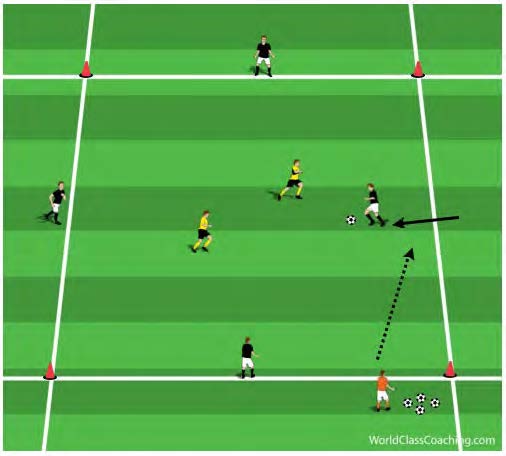WORLD CLASS COACHING
Soccer Intelligence
By Jason Carney
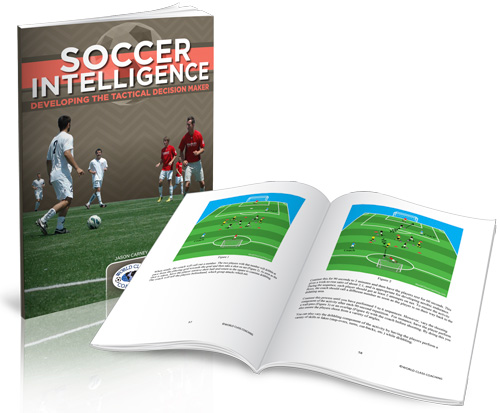
TABLE OF CONTENTS
Part Four
TACTICAL SMALL-SIDED GAMES
Tactical small sided games (Game related practices)
Allow the players to learn through playing
The priorities for youth today have changed and it is virtually impossible to get back to “the good old days” of street soccer. The coaching schools of the past (street soccer) are in decline. Children playing against each other on the streets or in the school playground are not as common as they used to be. Our coaching sessions have to be geared towards this kind of mindset that we had 20 years ago playing street soccer. Players (as learners) need to know ‘what’ they are doing or should be expected of them, as well as the ‘why’ and ‘how’. Incorporating quality practice sessions and small sided games can help players understand the ‘what, ‘why’ and ‘how’.
Why play small - sided games?
Small – sided games will allow the players to develop all the basic skills within the realization of a match, while they also encourage children to develop their own decision making skills. Small sided games will create problems for the players. They have to solve the problems that occur. These are valuable lessons for the future. When complicated situations arise in a real game situation, we want the players to think on their feet and solve the problems. Players will soon learn how to adapt to the changing situations and conditions of your small - sided games
What is a small – sided game?
A small – sided game is a game with few players, small field space and will have some restrictions or rules to follow that will encourage the players to problem solve. The problems that are being solved must be game related. It is vital that we do this at the foundation phase. Planting the seed for the player to blossom into a decision maker is the key component. Even something as simple as 5 v5 with a three touch restriction for players is a great small – sided game. This teaches speed of thought, movement and team-work.
The art of getting players to compete.
com·pete [kuhm-peet] verb (used without object), com·pet·ed, com·pet·ing. To strive to outdo another for acknowledgment, a prize, supremacy, profit, etc.; engage in a contest;
One of the problems coaches struggle with today is seeing their players show a lack of desire to compete. We know that screaming and yelling at them is not going to work. How can we fix this? This is where your planning skills come into play. Don’t just go home and ponder about the situation.
Take the philosophy we are teaching the players, ‘what’, ‘why’ and ‘how’. What exercises can I use to fix this? Why am I doing these exercises? How am I going to coach these exercises?
Introduce practice sessions that replicate aggressive play. This allows the players to learn how to deal with aggressive play and also learn to be aggressive themselves. We know we are trying to build team spirit so the aggressiveness has to be monitored and controlled. Tell the players that it is important to play within the rules. Your practice sessions should always have the rules of the game incorporated. The key is to make the players perform aggressive play without realizing it. To do this we must make our practice session fun and rewarding. Join in with the laughter. Praise the aggressive play whether it be a tackle or a willingness to run after the ball.
Do you add neutral players?
Some young players do not understand the addition of the neutral player. We are trying to teach competitive 1v1’s and 2v2’s so this can contradict our coaching style. If you feel your players can cope with this, then adding neutral players can improve your players on offense and defense. The neutral players that are most likely positioned in the midfield and given a free role, constantly will have decisions to make.
These players do not need to tackle. They play for whoever has the ball. Firstly, there is the decision-making and problem-solving relating to their movement and positioning before potentially receiving the ball, and then; where, when and how they receive it. Then comes the decision to run, retain or release as the other players react accordingly with their positioning. All players have to be aware of when the neutral player is with them or without them (speed of thought).
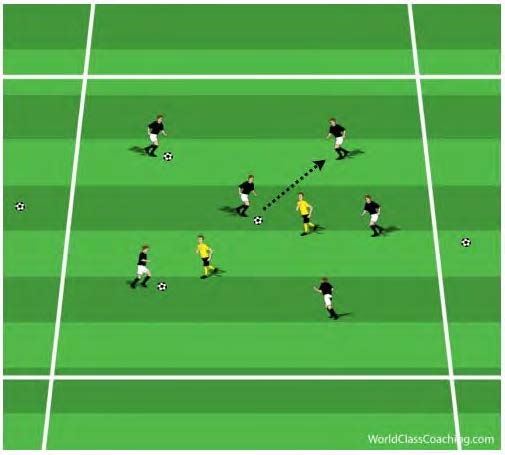
Fun, competitive keep away
Exercise:
Area – 20 x 20. This exercise shows eight players. Two yellow defenders and six dark attackers. All the dark players have a soccer ball.
1. The exercise starts with the two defenders entering the area and attempting to kick all the balls out of the playing area.
2. The dark players dribble and shield their ball from the defenders.
3. If a dark players ball is kicked out, they now become a support player for the other dark players.
4. You will eventually end up with one soccer ball and a 6 v 2.
5. Switch defenders.
Coaching points:
• When a player loses the ball, they must look around the area for the players that need help.
• Dribbling and shielding
• Communication and the use of space
• If the last ball gets kicked out, bring in another ball and coach spacing.

Fun, competitive passing with purpose
Exercise:
Area – 20 x 20. This exercise shows eight players. Two players each have a soccer ball.
1. The exercise starts with the two players with a ball dribbling around the area and trying to hit the other players below the knee.
2. This has to be done with a side foot pass.
3. If a player is hit below the knee they go and collect a ball from the coach and help to hit the other players.
4. Play until all players have been hit.
5. Switch roles.
Coaching points:
• The players with the ball must show energy, movement of the ball and quick turning reactions while chasing players.
• Do not allow this to get out of hand. Emphasize the importance of the pass.
• Pass with the side of your foot
• The contact made on the ball is in the middle, not on the bottom.
• Aim for the legs.
• If players kick the ball out of the area, they have to retrieve it.
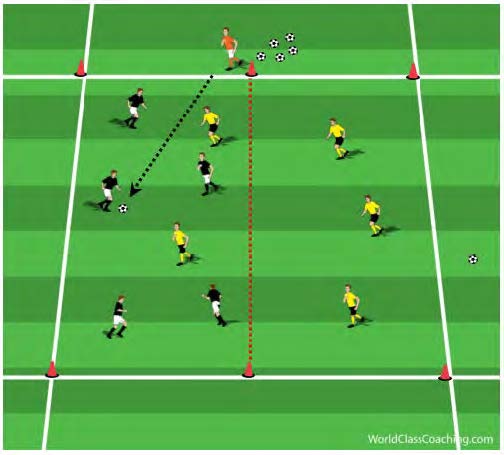
5v2 Keep away
Exercise:
• Area: Set up two 12 x 20 grids. Exercise shows 10 players, 5 v 5. (Can be done with more players)
• The coach has all the soccer balls.
1. The coach serves in a ball. Two defenders from the opposite team enter the area.
2. The purpose of the exercise is for the 5 players to play possession while the two defenders attempt to win the ball back and pass it to their team-mates in the opposite area.
3. If the defenders are successful, they then move back into their area along with two defenders from the opposite team.
4. If the ball is kicked out by a defender, the coach passes a ball back in for the attacking team to start playing again.
Variations:
• Play 5 v 3 if the group is more advanced.
• A bigger variation (8v8) can also be played. Make the field size larger.
Coaching points:
• Create space.
• Know when to take a touch or play a one touch pass.
• Communicate.
• Defenders close down passing angles.
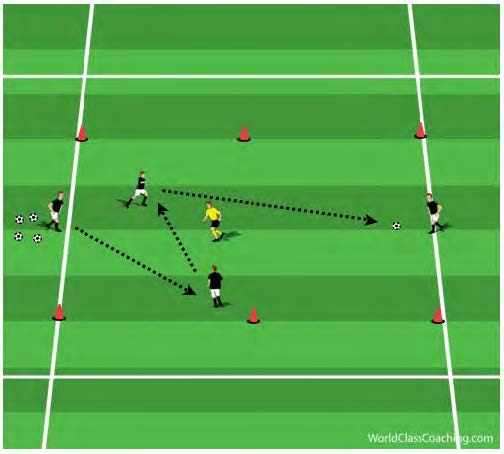
Playing a forward pass
Exercise:
• Area: Set up a 10 x 14 playing area. This exercise shows 5 players but you can run numerous stations.
• One end player has 5 soccer balls.
1. The object of the exercise is for the 5 balls to be passed to the opposite player using 2v1. Players can also use the end-line player as a team member.
2. The players in the middle can only use the 5 balls. If the defender wins a ball, that ball is ‘out’.
3. Once the balls have been transferred to the opposite end, the two attackers and the defender move to the opposite area and attempt to pass the rest of the balls to the opposite end..
4. See how many times the players can go back and forth.?
Variations:
• Play 2v2
Coaching points:
• Decision making. Outside passer chooses the best option.
• Body shape when receiving the ball.
• Fakes and turns.
• Patient build up.
• Team work.
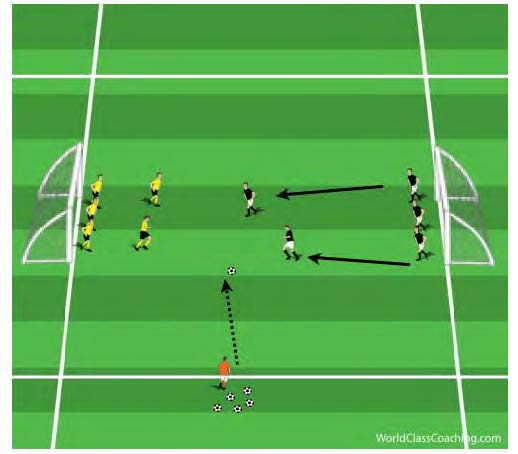
Fun 1v1, 2v2, 3v3 to goal
Exercise:
Area – 40 x 30. Two teams. The coach has all the soccer balls. Each team is standing in their goal, linking arms.
1. Each player is numbered 1 - 5.
2. The coach calls out a number (or two numbers) and serves in the ball.
3. The player with that number from each team enters the field, plays a 1 v 1, 2 v 2 etc and attempts to score on the opposition’s goal.
4. The remaining plays stay linked together and act as a large goal-keeper.
Variation:
• Call out more than one number.
Coaching points:
• Fun
• Enthusiasm
• Encourage players to be positive
• Attack at speed
• Close ball control
• Spacing when more than 1 v 1

3v2 to goal
Exercise:
Area – ¾ of a field. One goal with a goal keeper. Midfielders are 40 yards away from goal with the soccer balls. Defenders and strikers are located at both sides of the goal.
1. The exercise starts by two forwards running onto the field, followed by two defenders.
2. The midfield player passes to one of the forwards and joins in. This creates a 3v2 to goal.
3. Play stops if defenders win the ball or the ball goes out of bounds.
4. Players go back ‘Home’ and a new set of players restart the exercise.
Coaching points:
• Movement of strikers
• When to shoot, when to pass?
• Create shooting opportunities
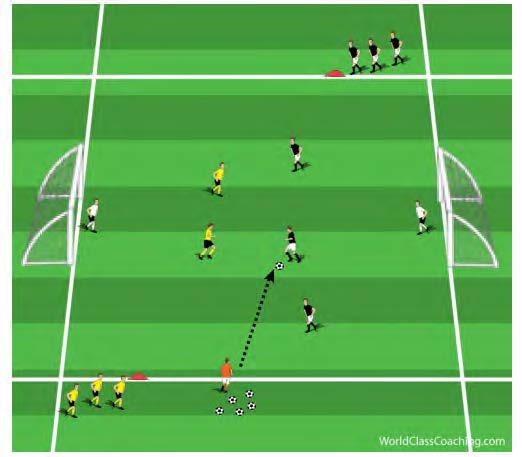
3v2 Transition - Advanced
Exercise:
• Area: 30 x 40 with two goals and two teams. Teams start 5 yards from the corner as shown.
• The coach has all the soccer balls.
1. Start with 3v2. The coach serves in a ball for the attacking three. Two defenders from the opposite team attempt to win the ball.
2. Possession changes hands when: A shot is taken or scored, the ball is won by the two defenders or the ball is kicked out of bounds.
3. As soon as the exercise is over, the attacking three quickly get off the field. They are replaced by two players from their team who become defenders.
4. The defending two are joined by a team-mate. If the defending two win the ball, they must now pass to the oncoming third player.
5. This oncoming player must always start the exercise in the 3v2. If the ball is scored or shot out of bounds, the coach will pass a ball to the oncoming third player.
Coaching points:
• Mental awareness.
• Know when to pass when to take a player on.
• Communicate.
• Make the extra player count.
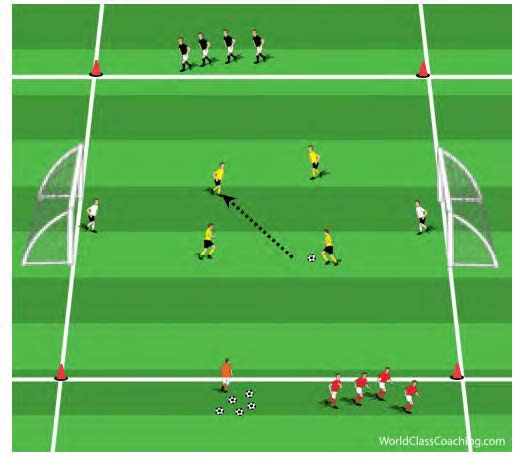
Pressing as a team
Exercise:
Area:30 x 30 with two goals with goalkeepers. There are 4 defenders on the field and two teams of four jogging on the outside. All three teams are separated by colored vests. The coach has all the soccer balls.
1. The coach passes a ball to the defenders. The defenders pass and move around the area.
2. The coach calls out a color “Red!”
3. The red team enters the field and attempts to win the ball from the defending team and score on either goal.
4. The defenders play possession soccer.
5. After a few tries, switch out the defenders.
Variation:
•You can play numbers up with the attackers, play 6 v 4
Coaching points:
• Pressure as a team
• Speed of thought when the ball is won by attackers
• Create scoring opportunities
• Communicate
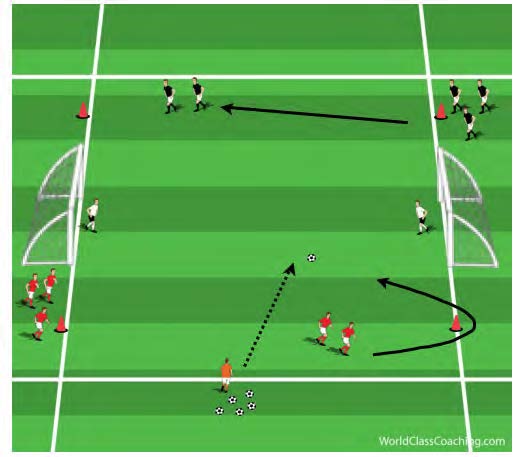
More fun 1v1, 2v2, 3v3 to goal plus fitness
Exercise:
Area – 25 x 30, 2 goals with GK’s
1. The coach calls out a number. If coach calls “TWO”, 2 players from each team run around the opposite cone as fast as they can. They now attack the goal they are facing.
2. The coach serves in the ball. A 2 v 2 is played.
3. Play until a goal is scored or until the ball goes out of bounds.
4. Players return back to their group.
Variation:
• Remove goalkeepers. The coach calls out a number. The first player around the cone becomes the goal keeper.
• The coach calls out a number, players add one. So, if coach calls out ”FOUR”, FIVE players go
Coaching points:
• Ball control, decision making, when to dribble? / pass? / shoot?
• Awareness
• Shooting
• Spacing when more than 1 v 1.
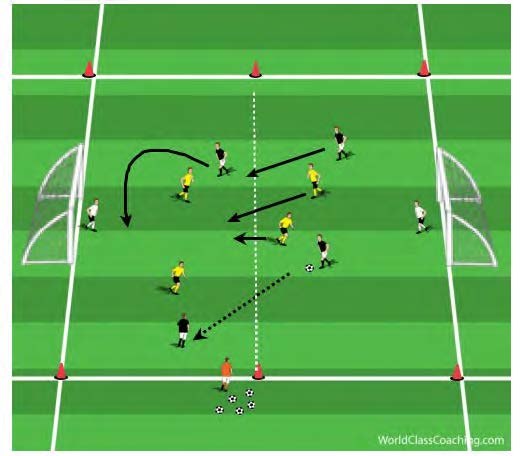
Small sided that works on defending and attacking as a team
Exercise:
Area – 60 x 40. Two teams, 5v5.
1.The teams play against each other.
2.The rules of the game are:
Attack together.
• When the attacking team looks like they are going to score, every player on the attacking team must be across the halfway line in the attacking half for a goal to count.
Defend together.
• All the defenders must be in their defending half. If not, and the attacking team scores, the goal counts as double.
Variation:
• Play two touch
• Add one or two neutral players
Coaching points:
• Attacking together does not mean leave open spaces at the back.
• Defend together

3 v 3 with transition
Exercise:
Area – 20 x 30. Play 3v3 with other team-mates standing by their own goal.
1.The teams play against each other.
2.The rules of the game are:
• On the coaches whistle, both teams leave the field leaving the ball where it is.
• They are replaced by three other teams who continue the game with the score remaining the same.
Coaching points:
• Encourage the players to play with intensity.
• Players should control and pass the ball using the correct technique.
• Movement off the ball is vital for this 3v3 exercise.
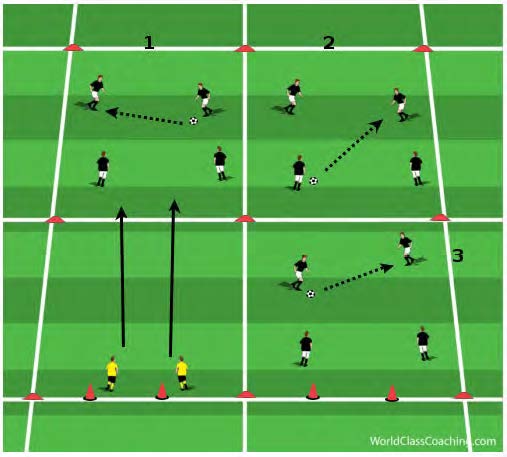
Team work - Being competitive
Exercise:
Area –– Four 12 x 12 boxes with 4 players in boxes 1, 2 and 3 with one ball in each box.
1. Two players start at the cones on the end-line as shown.
2. The players that are in the 12 x 12 area pass the ball and move in their own area working on their technique.
3. On the coaches signal, the two players sprint to box one and enter the 12 x 12 area.
4. They attempt to win the ball while the 4 players play keep away.
5. Once they win the ball, they move into box two until they have won the ball and then into box three. Once they win the ball in box three, they sprint through the two cones.
6. The coach times the players to see how long it takes.
Variation:
Play defenders against attackers as a group competition
Coaching points:
• Praise the competitive actions
• Team work

Play the ball forward
Exercise:
• Area – 25 x 40.
• This exercise is 3 v 3. The coach has all the soccer balls. Set-up is as shown above (shows two teams of 6 players) The strikers are placed on the middle cones.
1. Coach serves in the ball.
2. Can the receiving player find the target man?
3. If they do, they have to work together to get across the end line they are attacking. Yellows are attcking right to left.
Variation:
Two target players join in on the middle cone. It is now 4v4.
Coaching points:
• Decision making. When to pass / dribble?
• Movement
• Enthusiasm
• Team work
• Awareness
• Communication

Quick decision making
Exercise:
Area – 30 X 30. Two goals with Goalkeepers. Soccer balls are placed in the goals. One team at each side of a goal.
1. Dark players play a 3 v 2 against the yellow team.
2. Once a shot, a ball out of bounds or a tackle from the defenders, the yellow team receives a ball from Goal keeper ‘B’.
3. Two of the dark team players move to the end line of Goal ‘B’.
4. The yellow team now plays a 2 v 1 against the single dark team player, attacking Goal ‘A’.
5. Once a shot, a ball out of bounds or a tackle from the defender, all players come off. 3 new yellow team players receive a ball from Goal keeper ‘A’ and attack the opposite two dark team players…..and so on
Coaching points:
• Decision making. When to shoot / pass / dribble?
• Movement
• Enthusiasm
• Team work
• Awareness

Possession and running with the ball
Exercise:
Area – 60 x 30 (Three 20 x 30 grids) Middle zone is empty. The exercise is shown using 13 players. 5 v 2 in one grid 4 v 2 in the other.
1. 5 v 2 Grid. Players keep possession for 5 or more passes.
2. After 5 or more passes, a player can run with the ball to the next group to create a 5 v 2 in that grid.
3. They must pass the ball to a team-mate before entering the grid.
4. Players that are now in the 4 v 2 swap defenders.
5. The coach has all the balls so he / she can keep the game going.
Coaching points:
• Enthusiasm, intelligence and energy
• Patience in possession, movement to find space.
• Decision making to find the right player who can exploit the space in the middle zone.
Coaching pressure and cover
Exercise:
Area – 25 x 25. Four players are on the outside of the grid, 2 defenders in the middle. A server has all the balls. The ball is passed to one of the outside players.
1. The outside player has to attempt to dribble to the opposite end. If he / she feel they cannot do this, or want to challenge the defenders, they can pass to another outside player. If they pass to another defender, they go back to their own end line.
2. The two defenders work together to stop this.
3. Closest defender adds pressure and shows the attacker towards their partner, who offers cover.
4. Outside players do not turn this into a passing / keep away exercise. Encourage the players to dribble towards the defenders.
5. Keep switching defenders, servers and outside players.
Coaching points:
• Force the play one way
• Take a good defensive stance
• Encourage defenders to make the tackle.
• Communicate
Coaching defensive balance Part 1
Exercise:
• Area – Set up three (or four) 10 x 20 grids. Each grid has a goal at each end. The coach has all the soccer balls. • Players are placed at both sides of their goal.
• Part 1 is 1v1 and is played in one grid.
1. The coach serves in a ball to any player. That player plays a 1v1 against the player diagonally opposite.
2. The object is to score on the opposite goal.
Coaching points:
Force the play one way
Take a good defensive stance
Encourage defenders to make the tackle.

Coaching defensive balance Part 2
Exercise:
• Half of the players from each team move to the next grid.
• Part 2 is 2v2 and is played in two grids.
• Players must stay in their own grid.
1. The coach serves in a ball to any player. That player and their team mate in the opposite grid enter their playing area. Two defenders enter their playing area also.
2. Players can pass to each other to try and move the defenders but they must stay in their own playing area.
3. A goal can be scored on either goal. The object of the exercise is to teach the defender who is not adding pressure, to cover their goal.
Variation - Part 3:
Now move to the third grid and play 3 v 3. Watch how the players will offer instant cover and balance.
Coaching points:
• Force the play one way
• Take a good defensive stance
• Encourage defenders to make the tackle.
• Communication
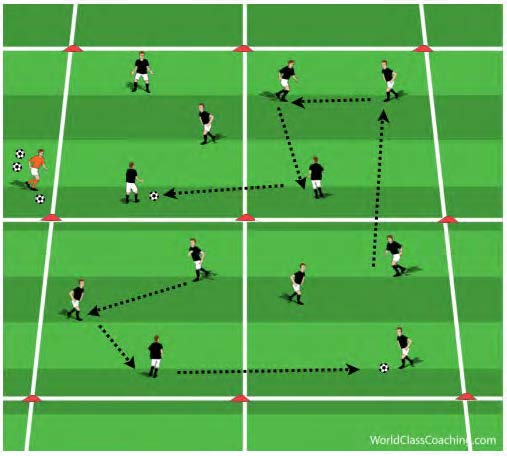
Body shape and passing
Exercise:
• Area – Four 15 x 15 grids (as shown)
• The Coach serves in the soccer balls. Two balls are used.
1. Every player must touch and pass the ball.
2. The last player to receive the ball passes anti clockwise to the next group.
3. The receiving player from that group passes the ball to a player in his / her group.
Variation:
• Add a third ball
• Add a fourth ball
• One touch only
Coaching points:
• Body shape. Players must be aware of who receives the next pass.
• Who will be in the best position to play the final pass?
• Quality of pass
• Communication
• Movement and enthusiasm
• Awareness

Body shape and passing Part 2
Exercise:
• The Coach has all the soccer balls. One ball is used.
• Two or three defenders are situated on the middle cone.
1. The coach serves a ball to one of the teams.
2. A defender now enters that area.
3. A 3 v 1 is played. The team in possession must make three or more passes before passing to any other area.
4. If they make the pass, the defender goes back to the center and the other defender moves into the area where the ball has been played, attempting to win the ball.
5. If the ball is won by the defender, the coach serves in another ball and the exercise continues.
Variation:
• Play two touch
• Coaching points:
• Body shape. Players must be aware of who receives the next pass.
• Quality of pass, Pass when the timing is right
• Communication, movement and awareness

Transition and awareness
Exercise:
• Area – 60 x 40, one soccer ball.
• 5v5v5 with five defenders holding a disc. This makes 10v5.
1. The teams are separated by colored vests.
2. Choose a defending team (yellow). All yellows are holding a disc.
3. The attacking teams play possession soccer. Once a defender wins possession of the soccer ball, all defenders drop the disc.
4. The team that lost possession or has kicked the ball out of bounds has to pick up a disc that has been dropped before they are allowed to defend the ball.
Variation:
• Play without holding cones.
• Coaching points:
• Possession. Move the ball quickly.
• Defending – contain the ball if your team mates have not yet picked up a disc.
• Pressure, cover and balance
• Communication
• Enthusiasm

